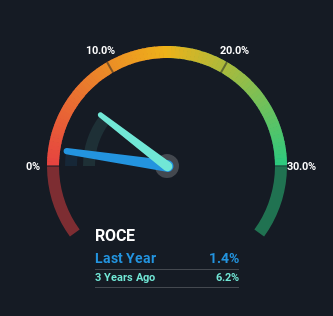- Hong Kong
- /
- Food and Staples Retail
- /
- SEHK:6618
Be Wary Of JD Health International (HKG:6618) And Its Returns On Capital

Did you know there are some financial metrics that can provide clues of a potential multi-bagger? Amongst other things, we'll want to see two things; firstly, a growing return on capital employed (ROCE) and secondly, an expansion in the company's amount of capital employed. Basically this means that a company has profitable initiatives that it can continue to reinvest in, which is a trait of a compounding machine. Although, when we looked at JD Health International (HKG:6618), it didn't seem to tick all of these boxes.
What Is Return On Capital Employed (ROCE)?
If you haven't worked with ROCE before, it measures the 'return' (pre-tax profit) a company generates from capital employed in its business. Analysts use this formula to calculate it for JD Health International:
Return on Capital Employed = Earnings Before Interest and Tax (EBIT) ÷ (Total Assets - Current Liabilities)
0.014 = CN¥685m ÷ (CN¥61b - CN¥13b) (Based on the trailing twelve months to June 2023).
So, JD Health International has an ROCE of 1.4%. Ultimately, that's a low return and it under-performs the Consumer Retailing industry average of 10.0%.
View our latest analysis for JD Health International

Above you can see how the current ROCE for JD Health International compares to its prior returns on capital, but there's only so much you can tell from the past. If you'd like, you can check out the forecasts from the analysts covering JD Health International here for free.
What Can We Tell From JD Health International's ROCE Trend?
When we looked at the ROCE trend at JD Health International, we didn't gain much confidence. Over the last five years, returns on capital have decreased to 1.4% from 39% five years ago. However, given capital employed and revenue have both increased it appears that the business is currently pursuing growth, at the consequence of short term returns. If these investments prove successful, this can bode very well for long term stock performance.
On a side note, JD Health International has done well to pay down its current liabilities to 20% of total assets. So we could link some of this to the decrease in ROCE. What's more, this can reduce some aspects of risk to the business because now the company's suppliers or short-term creditors are funding less of its operations. Since the business is basically funding more of its operations with it's own money, you could argue this has made the business less efficient at generating ROCE.
Our Take On JD Health International's ROCE
In summary, despite lower returns in the short term, we're encouraged to see that JD Health International is reinvesting for growth and has higher sales as a result. These growth trends haven't led to growth returns though, since the stock has fallen 27% over the last year. As a result, we'd recommend researching this stock further to uncover what other fundamentals of the business can show us.
While JD Health International doesn't shine too bright in this respect, it's still worth seeing if the company is trading at attractive prices. You can find that out with our FREE intrinsic value estimation on our platform.
If you want to search for solid companies with great earnings, check out this free list of companies with good balance sheets and impressive returns on equity.
New: Manage All Your Stock Portfolios in One Place
We've created the ultimate portfolio companion for stock investors, and it's free.
• Connect an unlimited number of Portfolios and see your total in one currency
• Be alerted to new Warning Signs or Risks via email or mobile
• Track the Fair Value of your stocks
Have feedback on this article? Concerned about the content? Get in touch with us directly. Alternatively, email editorial-team (at) simplywallst.com.
This article by Simply Wall St is general in nature. We provide commentary based on historical data and analyst forecasts only using an unbiased methodology and our articles are not intended to be financial advice. It does not constitute a recommendation to buy or sell any stock, and does not take account of your objectives, or your financial situation. We aim to bring you long-term focused analysis driven by fundamental data. Note that our analysis may not factor in the latest price-sensitive company announcements or qualitative material. Simply Wall St has no position in any stocks mentioned.
About SEHK:6618
JD Health International
An investment holding company, engages in the operation of an online healthcare platform in the People’s Republic of China and internationally.
Flawless balance sheet with proven track record.


